Polar-orbiting Weather Satellite Finishes Instrument Integration
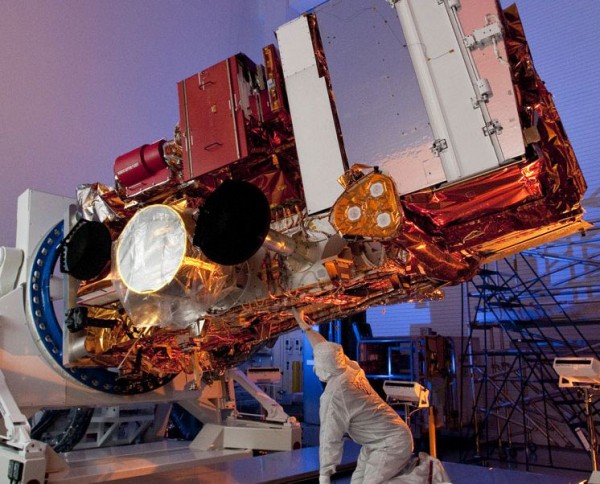

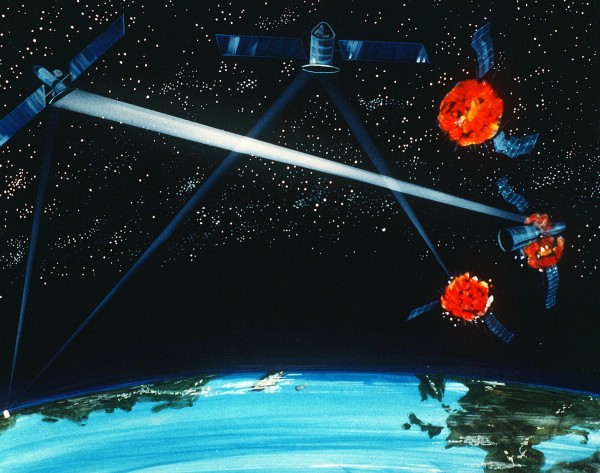
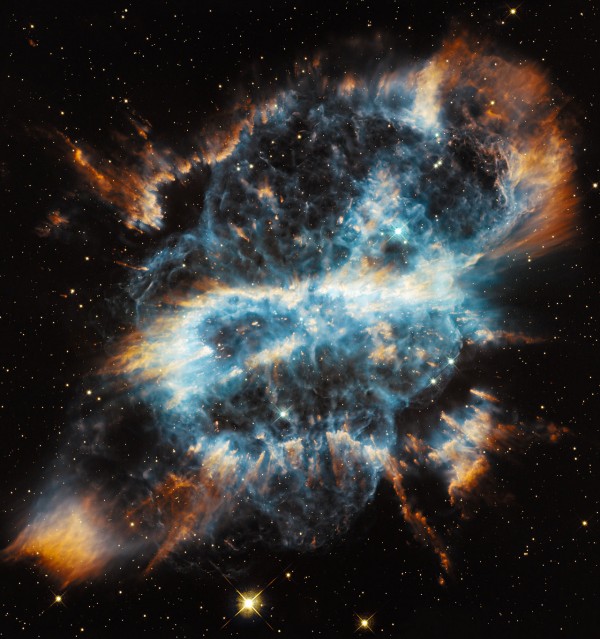
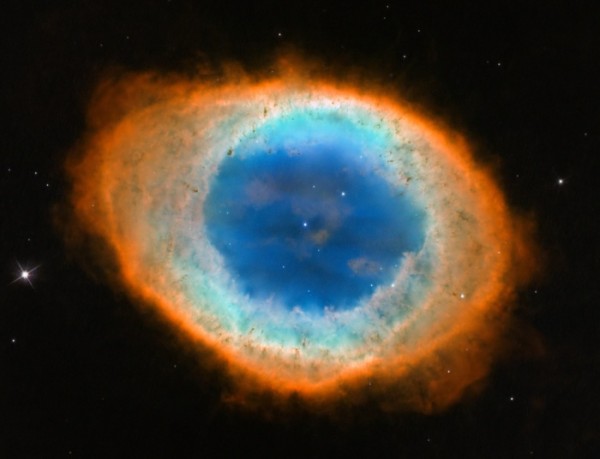
During its impressive 25 years the Hubble Space Telescope has captured numerous remarkable views of the universe, providing astronomers with a wealth of data for making astounding discoveries. Of all the beautiful astronomical objects observed by Hubble one of the most awe-inspiring is the massive, dying star V838 Moncerotis.
Hubble’s longevity has provided astronomers with a series of detailed images of V838 Mon captured between May 2002 and September 2006: the result is a fascinating “time-lapse” that uniquely illuminates the evolution of this massive, super-giant star. Hubble’s exceptionally sharp focus of V838 Mon offered a ring-side seat at the slow death of the star and excited astrophysicists with the chance to study the physics of the light, matter and microscopic dust of the interstellar medium.

NASA\ESA\H E Bond
V838 Mon is about 20,000 light-years away from Earth, in the direction of the constellation of Monoceros (the unicorn). This enormous distance places the star at the outskirts of our galaxy, the Milky Way. In 2002 the star underwent an enigmatic and spectacular brightening, briefly becoming one of the most luminous stars in the Galaxy.
This stellar flash blasted out radiation at a rate 600,000 times the output of our sun. The astounding Hubble images taken over the following years reveal the flash of light illuminating the shells of dust and gas that surround the star.
At first glace, the ring of colour suggests we are witnessing the gradual expansion of the ejected shell of the exploding star. But in fact what are seeing is an extraordinary “light echo”.
As light from the powerful flash propagates outward at 300,000km per second, it travels through successive rings of dust that surround the star. Some light is scattered by micron-sized dust particles in the dust clouds, reflected back towards the telescope and Earth. The scattered light has travelled a greater distance than the light that arrived directly from the original flash, and so arrives later. This light echo is the optical analogue of the more familiar sound echo, generated when for example thunder bounces of surrounding mountain-sides.

NASA\ESA\A Feild
The light echo discovered by Hubble reveals successive layers of matter and dust, spanning light-years across. The images betray earlier phases in the life of a now ageing, red super-giant star. The latest images in this time-lapse from 2005 and 2006 show an object around about six light-years in diameter, and reveal the turbulent and intricate structure of the interstellar medium, a region where it seems magnetic fields thread the space between stars.
All of these sharp images were taken using the Advanced Camera for Surveys (ACS), which had only just been installed on Hubble during a service mission in March 2002. The images approach true colours by combining data filtered to isolate blue, green and infrared light.

NASA\ESA\Z Levay
The cause of the powerful light flash remains mysterious and debated. One suggestion is that as V838 Mon evolves, its outer layers expand to engulf one or more unseen gas giant planets (or “hot Jupiters”) that may have orbited the star. The subsequent release of the planets’ gravitational energy could result in a brightening of the star, though it’s not certain whether this would be sufficient to explain the magnitude of the light flash. Another scenario is that it may have been the result on an unusual nova-like eruption, where matter from a companion star is pulled by gravity onto the surface of a collapsed white dwarf star, triggering a thermonuclear explosion.
The current leading theory is that a low-mass star, perhaps one-third of the mass of the sun, collided and merged with V838 Mon. The space between stars in enormous compared to the diameter of any star, and therefore stellar collisions are very rare. However, if a pair of stars is born together they will orbit each other, and with loss of orbital energy the low-mass companion may eventually be drawn into the more massive star. The result would be a huge blast of energy.
Transforming from an unremarkable speck in the sky to one of the most extraordinary and beautiful objects, the echoes of V838 Mon will be monitored by astronomers from space telescopes and those on the ground. V838 Mon continues to reveal more to us about the structure of stars, the nature of dust shells spreading into the interstellar medium, and the life – and death – of the most massive stars.
![]()
This article was originally published on The Conversation.
Read the original article.
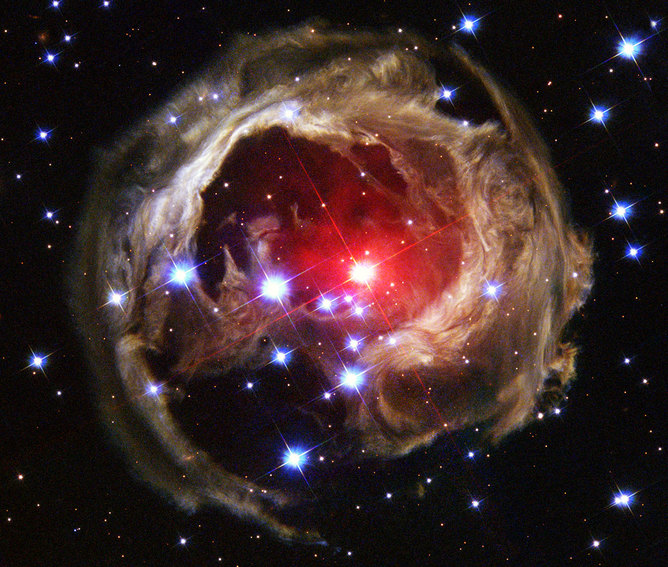
During its impressive 25 years the Hubble Space Telescope has captured numerous remarkable views of the universe, providing astronomers with a wealth of data for making astounding discoveries. Of all the beautiful astronomical objects observed by Hubble one of the most awe-inspiring is the massive, dying star V838 Moncerotis.
Hubble’s longevity has provided astronomers with a series of detailed images of V838 Mon captured between May 2002 and September 2006: the result is a fascinating “time-lapse” that uniquely illuminates the evolution of this massive, super-giant star. Hubble’s exceptionally sharp focus of V838 Mon offered a ringside seat at the slow death of the star and excited astrophysicists with the chance to study the physics of the light, matter and microscopic dust of the interstellar medium.

NASA\ESA\H E Bond
V838 Mon is about 20,000 light-years away from Earth, in the direction of the constellation of Monoceros (the unicorn). This enormous distance places the star at the outskirts of our galaxy, the Milky Way. In 2002 the star underwent an enigmatic and spectacular brightening, briefly becoming one of the most luminous stars in the Galaxy.
This stellar flash blasted out radiation at a rate 600,000 times the output of our sun. The astounding Hubble images taken over the following years reveal the flash of light illuminating the shells of dust and gas that surround the star.
At first glace, the ring of colour suggests we are witnessing the gradual expansion of the ejected shell of the exploding star. But in fact what are seeing is an extraordinary “light echo”.
As light from the powerful flash propagates outward at 300,000km per second, it travels through successive rings of dust that surround the star. Some light is scattered by micron-sized dust particles in the dust clouds, reflected back towards the telescope and Earth. The scattered light has travelled a greater distance than the light that arrived directly from the original flash, and so arrives later. This light echo is the optical analogue of the more familiar sound echo, generated when for example thunder bounces of surrounding mountain-sides.

NASA\ESA\A Feild
The light echo discovered by Hubble reveals successive layers of matter and dust, spanning light-years across. The images betray earlier phases in the life of a now ageing, red super-giant star. The latest images in this time-lapse from 2005 and 2006 show an object around about six light-years in diameter, and reveal the turbulent and intricate structure of the interstellar medium, a region where it seems magnetic fields thread the space between stars.
All of these sharp images were taken using the Advanced Camera for Surveys (ACS), which had only just been installed on Hubble during a service mission in March 2002. The images approach true colours by combining data filtered to isolate blue, green and infrared light.

NASA\ESA\Z Levay
The cause of the powerful light flash remains mysterious and debated. One suggestion is that as V838 Mon evolves, its outer layers expand to engulf one or more unseen gas giant planets (or “hot Jupiters”) that may have orbited the star. The subsequent release of the planets’ gravitational energy could result in a brightening of the star, though it’s not certain whether this would be sufficient to explain the magnitude of the light flash. Another scenario is that it may have been the result on an unusual nova-like eruption, where matter from a companion star is pulled by gravity onto the surface of a collapsed white dwarf star, triggering a thermonuclear explosion.
The current leading theory is that a low-mass star, perhaps one-third of the mass of the sun, collided and merged with V838 Mon. The space between stars in enormous compared to the diameter of any star, and therefore stellar collisions are very rare. However, if a pair of stars is born together they will orbit each other, and with loss of orbital energy the low-mass companion may eventually be drawn into the more massive star. The result would be a huge blast of energy.
Transforming from an unremarkable speck in the sky to one of the most extraordinary and beautiful objects, the echoes of V838 Mon will be monitored by astronomers from space telescopes and those on the ground. V838 Mon continues to reveal more to us about the structure of stars, the nature of dust shells spreading into the interstellar medium, and the life – and death – of the most massive stars.
![]()
This article was originally published on The Conversation.
Read the original article.
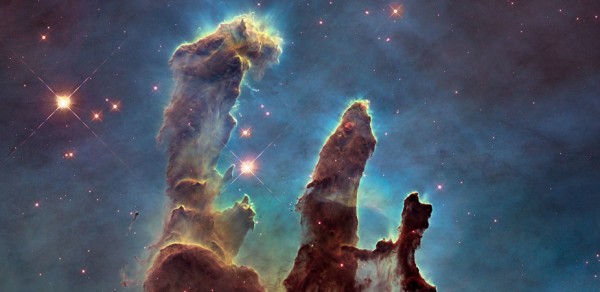
In this special feature, we have invited top astronomers to handpick the Hubble Space Telescope image that has the most scientific relevance to them. The images they’ve chosen aren’t always the colourful glory shots that populate the countless “best of” galleries around the internet, but rather their impact comes in the scientific insights they reveal.

NASA,ESA, M. Robberto (Space Telescope Science Institute/ESA) and the Hubble Space Telescope Orion Treasury Project Team
My all-time favourite astronomical object is the Orion Nebula – a beautiful and nearby cloud of gas that is actively forming stars. I was a high school student when I first saw the nebula through a small telescope and it gave me such a sense of achievement to manually point the telescope in the right direction and, after a fair bit of hunting, to finally track it down in the sky (there was no automatic ‘go-to’ button on that telescope).
Of course, what I saw on that long ago night was an amazingly delicate and wispy cloud of gas in black and white. One of the wonderful things that Hubble does is to reveal the colours of the universe. And this image of the Orion Nebula, is our best chance to imagine what it would look like if we could possibly go there and see it up-close.
So many of Hubble’s images have become iconic, and for me the joy is seeing its beautiful images bring science and art together in a way that engages the public. The entrance to my office, features an enormous copy of this image wallpapered on a wall 4m wide and 2.5m tall. I can tell you, it’s a lovely way to start each working day.

H. Hammel (SSI), WFPC2, HST, NASA
The impact of the fragments of Comet Shoemaker Levy 9 with Jupiter in July 1994 was the first time astronomers had advance warning of a planetary collision. Many of the world’s telescopes, including the recently repaired Hubble, turned their gaze onto the giant planet.
The comet crash was also my first professional experience of observational astronomy. From a frigid dome on Mount Stromlo, we hoped to see Jupiter’s moons reflect light from comet fragments crashing into the far side of Jupiter. Unfortunately we saw no flashes of light from Jupiter’s moons.
However, Hubble got an amazing and unexpected view. The impacts on the far side of Jupiter produced plumes that rose so far above Jupiter’s clouds that they briefly came into view from Earth.
As Jupiter rotated on its axis, enormous dark scars came into view. Each scar was the result of the impact of a comet fragment, and some of the scars were larger in diameter than our moon. For astronomers around the globe, it was a jaw dropping sight.

NASA, ESA and Jonathan Nichols (University of Leicester), CC BY
This pair of images shows a spectacular ultraviolet aurora light show occurring near Saturn’s north pole in 2013. The two images were taken just 18 hours apart, but show changes in the brightness and shape of the auroras. We used these images to better understand how much of an impact the solar wind has on the auroras.
We used Hubble photographs like these acquired by my astronomer colleagues to monitor the auroras while using the Cassini spacecraft, in orbit around Saturn, to observe radio emissions associated with the lights. We were able to determine that the brightness of the auroras is correlated with higher radio intensities.
Therefore, I can use Cassini’s continuous radio observations to tell me whether or not the auroras are active, even if we don’t always have images to look at. This was a large effort including many Cassini investigators and Earth-based astronomers.

NASA and John Clarke (Boston University), CC BY
This far-ultraviolet image of Jupiter’s northern aurora shows the steady improvement in capability of Hubble’s scientific instruments. The Space Telescope Imaging Spectrograph (STIS) images showed, for the first time, the full range of auroral emissions that we were just beginning to understand.
The earlier Wide Field Planetary Camera 2 (WFPC2) camera had shown that Jupiter’s auroral emissions rotated with the planet, rather than being fixed with the direction to the sun, thus Jupiter did not behave like the Earth.
We knew that there were aurora from the mega-ampere currents flowing from Io along the magnetic field down to Jupiter, but we were not certain this would occur with the other satellites. While there were many ultraviolet images of Jupiter taken with STIS, I like this one because it clearly shows the auroral emissions from the magnetic footprints of Jupiter’s moons Io, Europa, and Ganymede, and Io’s emission clearly shows the height of the auroral curtain. To me it looks three-dimensional.
Take a good look at these images of the dwarf planet, Pluto, which show detail at the extreme limit of Hubble’s capabilities. A few days from now, they will be old hat, and no-one will bother looking at them again.
Why? Because in early May, the New Horizons spacecraft will be close enough to Pluto for its cameras to reveal better detail, as the craft nears its 14 July rendezvous.
Yet this sequence of images – dating from the early 2000s – has given planetary scientists their best insights to date, the variegated colours revealing subtle variations in Pluto’s surface chemistry. That yellowish region prominent in the centre image, for example, has an excess of frozen carbon monoxide. Why that should be is unknown.
The Hubble images are all the more remarkable given that Pluto is only 2/3 the diameter of our own moon, but nearly 13,000 times farther away.

HST / Adam Schneider (University of Toledo)/Chris Tinney (UNSW)
I once dragged my wife into my office to proudly show her the results of some imaging observations made at the Anglo-Australian Telescope with a (then) new and (then) state-of-the-art 8,192 x 8,192 pixel imager. The images were so large, they had to be printed out on multiple A4 pages, and then stuck together to create a huge black-and-white map of a cluster of galaxies that covered a whole wall.
I was crushed when she took one look and said: “Looks like mould”.
Which just goes to show the best science is not always the prettiest.
My choice of the greatest image from HST is another black-and-white image from 2012 that also “looks like mould”. But buried in the heart of the image is an apparently unremarkable faint dot. However it represents the confirmed detection of the coldest example of a brown dwarf then discovered. An object lurking less than 10 parsecs (32.6 light years) away from the sun with a temperature of about 350 Kelvin (77 degrees Celsius) –- colder than a cup of tea!
And to this day it remains one of the coldest compact objects we’ve detected outside out solar system.

NASA/ESA/STScI, processing by Lucas Macri (Texas A&M University). Observations carried out as part of HST Guest Observer program 9810.
In 2004, I was part of a team that used the recently-installed Advanced Camera for Surveys (ACS) on Hubble to observe a small region of the disk of a nearby spiral galaxy (Messier 106) on 12 separate occasions within 45 days. These observations allowed us to discover over 200 Cepheid variables, which are very useful to measure distances to galaxies and ultimately determine the expansion rate of the universe (appropriately named the Hubble constant).
This method requires a proper calibration of Cepheid luminosities, which can be done in Messier 106 thanks to a very precise and accurate estimate of the distance to this galaxy (24.8 million light-years, give or take 3%) obtained via radio observations of water clouds orbiting the massive black hole at its center (not included in the image).
A few years later, I was involved in another project that used these observations as the first step in a robust cosmic distance ladder and determined the value of the Hubble constant with a total uncertainty of 3%.

NASA, ESA and H.E. Bond (STScI), CC BY
One of the images that excited me most – even though it never became famous – was our first one of the light echo around the strange explosive star V838 Monocerotis. Its eruption was discovered in January 2002, and its light echo was discovered about a month later, both from small ground-based telescopes.
Although light from the explosion travels straight to the Earth, it also goes out to the side, reflects off nearby dust, and arrives at Earth later, producing the “echo.”
Astronauts had serviced Hubble in March 2002, installing the new Advanced Camera for Surveys (ACS). In April, we were one of the first to use ACS for science observations.
I always liked to think that NASA somehow knew that the light from V838 was on its way to us from 20,000 light-years away, and got ACS installed just in time! The image, even in only one color, was amazing. We obtained many more Hubble observations of the echo over the ensuing decade, and they are some of the most spectacular of all, and VERY famous, but I still remember being awed when I saw this first one.

X-ray: NASA/CXC/Univ of Iowa/P.Kaaret et al.; Optical: NASA/ESA/STScI/Univ of Iowa/P.Kaaret et al., CC BY-NC
Galaxies form stars. Some of those stars end their “normal” lives by collapsing into black holes, but then begin new lives as powerful X-ray emitters powered by gas sucked off a companion star.
I obtained this Hubble image (in red) of the Medusa galaxy to better understand the relation between black hole X-ray binaries and star formation. The striking appearance of the Medusa arises because it’s a collision between two galaxies – the “hair” is remnants of one galaxy torn apart by the gravity of the other. The blue in the image shows X-rays, imaged with the Chandra X-ray Observatory. The blue dots are black hole binaries.
Earlier work had suggested that the number of X-ray binaries is simply proportional to the rate at which the host galaxy forms stars. These images of the Medusa allowed us to show that the same relation holds, even in the midst of galactic collisions.

NASA, ESA, the Hubble Heritage (STScI/AURA)-ESA/Hubble Collaboration, and A. Evans (University of Virginia, Charlottesville/NRAO/Stony Brook University), CC BY
Some of the Hubble Space Telescope images that appeal to me a great deal show interacting and merging galaxies, such as the Antennae (NGC 4038 and NGC 4039), the Mice (NGC 4676), the Cartwheel galaxy (ESO 350-40), and many others without nicknames.
These are spectacular examples of violent events that are common in the evolution of galaxies. The images provide us with exquisite detail about what goes on during these interactions: the distortion of the galaxies, the channeling of gas towards their centers, and the formation of stars.
I find these images very useful when I explain to the general public the context of my own research, the accretion of gas by the supermassive black holes at the centers of such galaxies. Particularly neat and useful is a video put together by Frank Summers at the Space Telescope Science Institute (STScI), illustrating what we learn by comparing such images with models of galaxy collisions.

NASA, Holland Ford (JHU), the ACS Science Team and ESA
Our best computer simulations tell us galaxies grow by colliding and merging with each other. Similarly our theories tell us that when two spiral galaxies collide, they should form a large elliptical galaxy. But actually seeing it happen is another story entirely!
This beautiful Hubble image has captured a galaxy collision in action. This doesn’t just tell us that our predictions are good, but it lets us start working out the details because we can now see what actually happens.
There are fireworks of new star formation triggered as the gas clouds collide and huge distortions going on as the spiral arms break up. We have a long way to go before we’ll completely understand how big galaxies form, but images like this are pointing the way.

NASA and The Hubble Heritage Team (STScI/AURA)
This is the highest-resolution view of a collimated jet powered by a supermassive black hole in the nucleus of the galaxy M87 (the biggest galaxy in the Virgo Cluster, 55 million light years from us).
The jet shoots out of the hot plasma region surrounding the black hole (top left) and we can see it streaming down across the galaxy, over a distance of 6,000 light-years. The white/purple light of the jet in this stunning image is produced by the stream of electrons spiralling around magnetic field lines at a speed of approximately 98% of the speed of light.
Understanding the energy budget of black holes is a challenging and fascinating problem in astrophysics. When gas falls into a black hole, a huge amount of energy is released in the form of visible light, X-rays and jets of electrons and positrons travelling almost at the speed of light. With Hubble, we can measure the size of the black hole (a thousand times bigger than the central black hole of our galaxy), the energy and speed of its jet, and the structure of the magnetic field that collimates it.

NASA, Jayanne English (University of Manitoba), Sally Hunsberger (Pennsylvania State University), Zolt Levay (Space Telescope Science Institute), Sarah Gallagher (Pennsylvania State University), and Jane Charlton (Pennsylvania State University), CC BY
When my Hubble Space Telescope proposal was accepted in 1998 it was one of the biggest thrills of my life. To imagine that, for me, the telescope would capture Stephan’s Quintet, a stunning compact group of galaxies!
Over the next billion years Stephan’s Quintet galaxies will continue in their majestic dance, guided by each other’s gravitational attraction. Eventually they will merge, change their forms, and ultimately become one.
We have since observed several other compact groups of galaxies with Hubble, but Stephan’s Quintet will always be special because its gas has been released from its galaxies and lights up in dramatic bursts of intergalactic star formation. What a fine thing to be alive at a time when we can build the Hubble and push our minds to glimpse the meaning of these signals from our universe. Thanks to all the heroes who made and maintained Hubble.

NASA, Andrew Fruchter and the ERO Team [Sylvia Baggett (STScI), Richard Hook (ST-ECF), Zoltan Levay (STScI)] (STScI)
When Hubble was launched in 1990, I was beginning my PhD studies into gravitational lensing, the action of mass bending the paths of light rays as they travel across the universe.
Hubble’s image of the massive galaxy cluster, Abell 2218, brings this gravitational lensing into sharp focus, revealing how the massive quantity of dark matter present in the cluster – matter that binds the many hundreds of galaxies together – magnifies the light from sources many times more distant.
As you stare deeply into the image, these highly magnified images are apparent as long thin streaks, the distorted views of baby galaxies that would normally be impossible to detect.
It gives you pause to think that such gravitational lenses, acting as natural telescopes, use the gravitational pull from invisible matter to reveal amazing detail of the universe we cannot normally see!

NASA, ESA, J. Rigby (NASA Goddard Space Flight Center), K. Sharon (Kavli Institute for Cosmological Physics, University of Chicago), and M. Gladders and E. Wuyts (University of Chicago)
Gravitational lensing is an extraordinary manifestation of the effect of mass on the shape of space-time in our universe. Essentially, where there is mass the space is curved, and so objects viewed in the distance, beyond these mass structures, have their images distorted.
It’s somewhat like a mirage; indeed this is the term the French use for this effect. In the early days of the Hubble Space Telescope, an image appeared of the lensing effects of a massive cluster of galaxies: the tiny background galaxies were stretched and distorted but embraced the cluster, almost like a pair of hands.
I was stunned. This was a tribute to the extraordinary resolution of the telescope, operating far above the Earth’s atmosphere. Viewed from the ground, these extraordinary thin wisps of galactic light would have been smeared out and not distinguishable from the background noise.
My third year astrophysics class explored the 100 Top Shots of Hubble, and they were most impressed by the extraordinary, but true colours of the clouds of gas. However I cannot go past an image displaying the effect of mass on the very fabric of our universe.

NASA, ESA, J. Richard (Center for Astronomical Research/Observatory of Lyon, France), and J.-P. Kneib (Astrophysical Laboratory of Marseille, France), CC BY
With General Relativity, Einstein postulated that matter changes space-time and can bend light. A fascinating consequence is that very massive objects in the universe will magnify light from distant galaxies, in essence becoming cosmic telescopes.
With the Hubble Space Telescope, we have now harnessed this powerful ability to peer back in time to search for the first galaxies.
This Hubble image shows a hive of galaxies that have enough mass to bend light from very distant galaxies into bright arcs. My first project as a graduate student was to study these remarkable objects, and I still use the Hubble today to explore the nature of galaxies across cosmic time.

NASA, ESA, H. Teplitz, M. Rafelski (IPAC/Caltech), A. Koekemoer (STScI), R. Windhorst (Arizona State University), and Z. Levay (STScI)
To the human eye, the night sky in this image is completely empty. A tiny region no thicker than a grain of rice held at arms length. The Hubble Space Telescope was pointed at this region for 12 full days, letting light hit the detectors and slowly, one by one, the galaxies appeared, until the entire image was filled with 10,000 galaxies stretching all the way across the universe.
The most distant are tiny red dots tens of billions of light years away, dating back to a time just a few hundred million years after the Big Bang. The scientific value of this single image is enormous. It revolutionised our theories both of how early galaxies could form and how rapidly they could grow. The history of our universe, as well as the rich variety of galaxy shapes and sizes, is contained in a single image.
To me, what truly makes this picture extraordinary is that it gives a glimpse into the scale of our visible universe. So many galaxies in so small an area implies that there are 100 thousand million galaxies across the entire night sky. One entire galaxy for every star in our Milky Way!

NASA, ESA, and J. Lotz, M. Mountain, A. Koekemoer, and the HFF Team (STScI), CC BY
This is what Hubble is all about. A single, awe-inspiring view can unmask so much about our Universe: its distant past, its ongoing assembly, and even the fundamental physical laws that tie it all together.
We’re peering through the heart of a swarming cluster of galaxies. Those glowing white balls are giant galaxies that dominated the cluster center. Look closely and you’ll see diffuse shreds of white light being ripped off of them! The cluster is acting like a gravitational blender, churning many individual galaxies into a single cloud of stars.
But the cluster itself is just the first chapter in the cosmic story being revealed here. See those faint blue rings and arcs? Those are the distorted images of other galaxies that sit far in the distance.
The immense gravity of the cluster causes the space-time around it to warp. As light from distant galaxies passes by, it’s forced to bend into weird shapes, like a warped magnifying glass would distort and brighten our view of a faint candle. Leveraging our understanding of Einstein’s General Relativity, Hubble is using the cluster as a gravitational telescope, allowing us to see farther and fainter than ever before possible. We are looking far back in time to see galaxies as they were more than 13 billion years ago!
As a theorist, I want to understand the full life cycle of galaxies – how they are born (small, blue, bursting with new stars), how they grow, and eventually how they die (big, red, fading with the light of ancient stars). Hubble allows us to connect these stages. Some of the faintest, most distant galaxies in this image are destined to become monster galaxies like those glowing white in the foreground. We’re seeing the distant past and the present in a single glorious picture.
![]()
This article was originally published on The Conversation.
Read the original article.
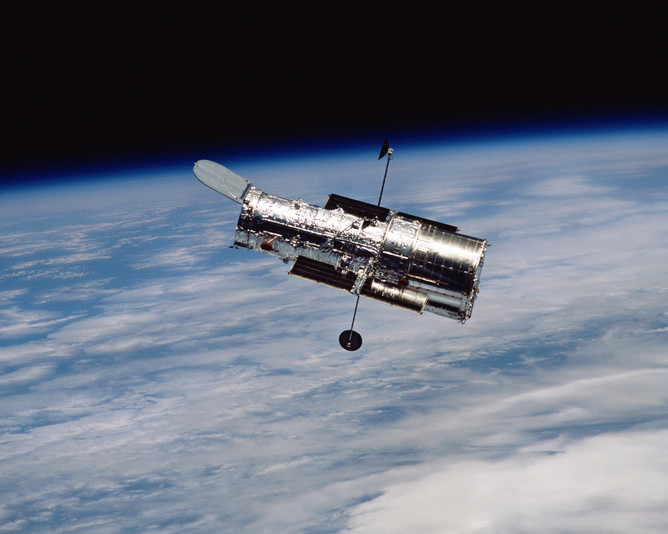
Iconic images of astronomical pillars of gas and dust, views of galaxies soon after they were formed, an accelerating universe driven by Dark Energy… “give us more!” say the public and the taxpayers. The Hubble Space Telescope is undoubtedly one of the most popular science projects today. It was not always thus.
With its origins dating back to a time when almost all astronomers used photographic plates to record images at ground-based telescopes, the idea of an ambitious and expensive observatory in space was not a popular one.

The most influential astronomers of the 1960s thought it better to spend the money on 15 copies of the 200-inch giant on Palomar Mountain, rather than gamble all on a single telescope in space that was not as large.
Nevertheless, NASA held out the Hubble as a long-term goal. By the early 1970s, things began to change as preliminary designs for the spacecraft were generated and my colleagues were educated about the Hubble’s potential.
This space-based telescope would be able to make images of a step up in quality that was as great as Galileo’s application of the first astronomical telescope was to the view with an unaided eye. It would detect stars and galaxies that lay beyond the limit of faintness of giant ground-based observatories. I left my professorship at the University of Chicago in 1972 to become the scientific leader of the proposed project and considered the gathering of scientific support my most important immediate job.
Finally the idea caught on and scientists and groups from most of the major observatories in the US and Europe became involved with building the observatory, its individual scientific instruments, and planning the science to be done. From widespread skepticism, the situation changed to astronomers not wanting to miss the boat.

NASA
The first few years were spent in preliminary design of many types of scientific instruments, using competitively selected scientists. As we moved into the selection of teams to build the instruments, we held a new competition. The teams who had proposed the most modern approaches were selected, leaving behind some people involved since the earliest studies.

NASA Marshall Space Flight Center
Hardware began to be built in 1977, even before the Hubble was funded by Congress in fiscal year 1978. Preparations proceeded on the bumpy and expensive path that would lead to its being ready for launch in late 1986. But then the space shuttle Challenger accident occurred and several years of delay ensued as the Space Transportation System came back into operation. Hubble eventually hitched a ride to space onboard Space Shuttle Discovery in April, 1990.

Right: NASA, ESA, and STScI Left: E. Persson (Las Campanas Observatory, Chile)/Observatories of the Carnegie Institution of Washington
Within a few weeks it looked like those early skeptics were the wise ones amongst us. The telescope’s primary mirror had been created with great precision and measured with unprecedented accuracy; but the measuring equipment was misaligned. That error resulted in a mirror that formed a degraded image. Instead of a single sharp core where 90% of the light focused, there was a sharp core with 20% of the light surrounded by a halo. We were pilloried, investigated, and a subject of mean-spirited cartoons. Techno-Turkey was a popular description.
However, researchers developed computer programs to accurately remove the halo and the scientific value of the resulting images began to be appreciated. Over the next several years the articles on the Hubble changed from the initial subjects of “how can such a major screw-up occur,“ to lead-ins of “the crippled Hubble has shown this interesting scientific result,” until finally the science stories would simply end with a mention in the last paragraph that the Hubble was working with a flawed mirror, but it was expected that things would be improved after the first servicing mission.

STScI
And improve they did with the servicing mission of December 1993. That success reflected the finest hours (years actually) of NASA and Aerospace engineers and managers, the Space Telescope Science Institute and the Astronaut Corps. The scientific instruments were housed in easily changed-out boxes. An empty instrument box had been made before the 1990 launch to be used in case one of the scientific instruments was not ready in time.
This box was altered to house a set of mirrors that would correct the convergent light beam coming from the flawed primary mirror so it would reach the scientific instruments in pristine condition. A backup imaging camera was installed that had the correction figured into the internal mirrors that were already part of its design. The Hubble was saved and was actually producing images better than we had publicly predicted.

NASA
Happily, the rest is history.

NASA, ESA, and the Hubble Heritage Team (STScI/AURA), CC BY
The four additional servicing missions have replaced failed components, repaired instruments in-orbit, and replaced support-equipment (for example the data recorders and computers) and scientific instruments, so that today’s Hubble is more powerful than ever. Without the ability to conduct additional servicing missions, its lifetime will be limited. Whatever time we still have will be welcome, but in any event, the Hubble Space Telescope must be considered a triumph.

Mark McCaughrean (Max-Planck-Institute for Astronomy), C. Robert O’Dell (Rice University), and NASA, CC BY
It has been gratifying to be on the ground floor of the Hubble project and to shape the direction that it’s taken. Engineering images of my favorite astronomical object, the Orion Nebula, were made before that first servicing mission. I was given access to those and in their analysis discovered the objects now called proplyds. These are the circumstellar material and proto-planetary disks surrounding very young stars (ages much less than one million years).

STScI
These discoveries started a series of investigations using the Hubble that continues today. I’ve just submitted a paper on the most recent of these for publication. It exploits the fact that the long difference in time between the earliest and most recent images allows us to see changes in the nebula and to trace the matter being expelled from the youngest of the stars in Orion, thus illuminating the process by which stars and their planets are formed.
It’s just one of the discoveries we certainly wouldn’t have made by now without a space telescope like the Hubble.
![]()
This article was originally published on The Conversation.
Read the original article.
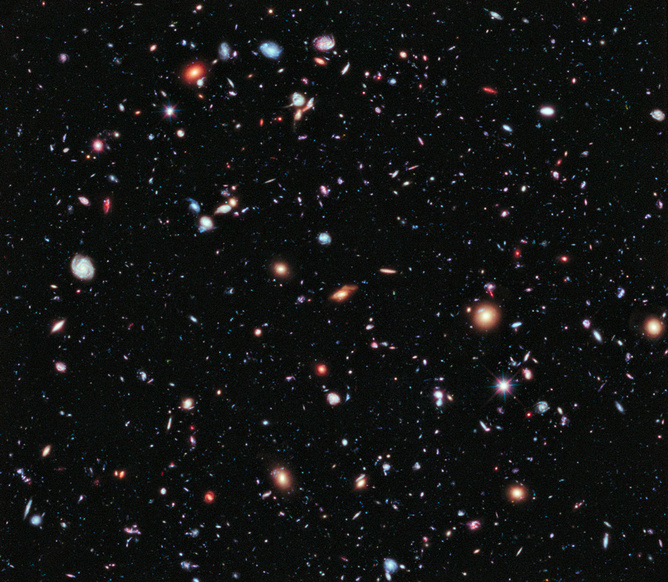
This insignificant patch of sky in the fairly obscure constellation of Fornax is the setting for one of the most remarkable images ever captured. Although only a fraction of the full moon in size, this image traces thousands of distant galaxies to the edge of the observable universe.
The Hubble Space Telescope began observing “deep fields” in 1995. The idea was not new – astronomers have always tried to take longer photographic captures that draw in more light to reveal ever more faint and distant objects. Observing more distant galaxies sheds light on how they form, and how their shapes and sizes change over time. Hubble’s key advantage is that, floating in orbit, it’s unaffected by the blurring effect of the atmosphere and so can provide images of far superior resolution than ground-based telescopes.
Careful planning was required for the deep field images. An “empty” piece of sky was needed that contained no bright sources of visible light that might drown out fainter objects. There could also be no bright sources at other wavelengths, such as X-ray or radio waves where complementary supporting observations might be made. The direction chosen was away from the millions of faint stars and dust of the plane of our own galaxy, the Milky Way.

Digitised Sky Survey (DSS), STScI/AURA, Palomar/Caltech, and UKSTU/AAO
This was not without risk, however. Hubble was, and still is, a hugely popular, world-class research facility. It is typical that demand for Hubble’s instruments outstrips availability by six or seven times. There was always the possibility that the 10 days observation required might reveal the carefully-chosen blank part of the sky to be just that: blank.
Instead the results of the first Hubble Deep Field image were breathtaking. After stitching together the composite images and careful processing, the final image revealed around 3,000 galaxies, most of which would otherwise have never been seen. This success triggered plans for further “deep field” images.
A southern-hemisphere counterpart followed in 1998, and after a powerful instrument upgrade in 2002, the Hubble Ultra Deep Field images were taken in 2004.
Finally, advances in data processing techniques, some new infrared data and more images of Ultra Deep Field area were in 2012 combined to create the Hubble eXtreme Deep Field (HXDF), the main image above, and the same image with ultraviolet included, below – humanity’s most sensitive images of the cosmos ever taken.

NASA\ESA\IPAC\Caltech\STScI\Arizona State University
The HXDF image is the result of 2m seconds (more than 23 days) of exposure time taken over the course of 2,963 images. The captures that make up the composite image are sensitive to light from the ultraviolet to the near-infrared spectrum, which are used in the processing to create the colours visible. The faintest objects in the HXDF, barely visible on screen, are a remarkable ten-billionth the brightness of the faintest star visible to the naked eye.

NASA/ESA/H. Richer
A handful of the objects in the image are comparatively “nearby” foreground stars in our own galaxy located perhaps a few tens or hundreds of light-years away. Although the field was chosen to have few of these, some faint stars are present. The stars are quite easy to identify due to the diffraction spikes caused by Hubble’s optics – the tell-tale cross of light across their centre. All the other objects in the image are galaxies.

NASA/ESA/Z. Levay/F. Summers
The image acts a little like a time machine. The further away a galaxy is, the longer it has taken light to reach us – and the earlier in the universe we are looking. Since that light was emitted the universe has continued to expand. Some galaxies in the picture lie close to the edge of the observable universe. This is the furthest point in space to which we could, in principle, see. This is about 45 billion light years from the Earth: light from more distant objects has not yet had time to reach us.
Some of these galaxies are comparatively near by, perhaps a few hundreds of millions of light years away. These are the bigger objects in the picture: blue or white galaxies with sharply-focused spiral arms, or large red and orange blurs. Galaxies like this are very similar to galaxies we see near the Milky Way.
The most distant objects look very different to galaxies nearer to us, tracing how rapidly galaxies change in the early universe. They shine brightly with the light of young stars, revealing that more stars are formed in the early universe than previously thought.

NASA, ESA, and Z. Levay (STScI)
One of these objects, dubbed 39546284 in the zoomed picture above, is thought to be the most distant: it has taken light about 13.3 billion years to reach us (the universe itself is thought to be about 13.7 billion years old). Many of these very young galaxies will eventually evolve into galaxies that look more like the Milky Way.
The image also contains a few supernovae, exploding stars detected more than halfway across the universe. SN Primo is one of these, nearly ten billion light years away. Supernovae like these are being used to map out the expansion history of the universe.
Perhaps the most remarkable fact is that this image represents just a tiny fraction of our universe. All told, there are estimated to be some 100 to 200 billion galaxies in the universe, of which only just over 5,000 appear in the HXDF. Put another way, you’d need about 30m images like the HXDF to map the entire sky.
This remarkable image will be one of Hubble’s lasting legacies. With the Space Shuttle now retired from service, there are no future servicing missions planned. This means no future instrument upgrades, so it’s unlikely that Hubble will ever be able to improve significantly on the depth of this image. That honour may await the James Webb Space Telescope, scheduled for launch in 2018, and the beginning of another astronomical legacy.
![]()
This article was originally published on The Conversation.
Read the original article.

